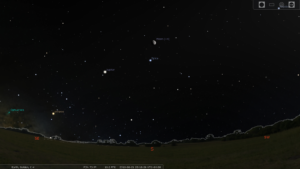
This view is at mid-day, as the sun crosses the meridian (the green line) and is as it would appear if we could eliminate the Earth’s atmosphere and see the sun, moon, planets and stars set against a jet-black sky. Note that the angular separation between the sun’s position on the ecliptic (the red line and the imaginary path all solar-system objects appear to travel on) and the celestial equator (the blue line and the projection of the earth’s equator onto the sky). This separation between the sun’s position on the ecliptic at the Summer Solstice and the Celestial Equator is exactly equal to our planet’s angular tilt from the vertical of 23.5º.
As the last vestiges of the winter sky are low in the west at twilight, we look forward to the late spring and early summer sky.
With Lyra the celestial harp ascending the northeastern sky towards midnight along with Cygnus and the rich summer Milky Way following close behind, we’re certain that spring is here and that summer will soon follow. Many would consider this their favorite time of year, a time that harkens back to younger days, to a time when you could see magnitude 5.5 stars (the faintest stars visible to the eye are magnitude 6) and a breathtaking view of the Milky Way from many suburbs. With the fresh spring air, the sweet smell of Lilacs and Honey Suckle wafting about and the temperature and humidity still moderate, it’s truly a pleasure to be out under the stars.
The Summer Solstice Occurs on June 21st this Year
Placed high in the west after sunset, you’ll see brilliant Venus, located in Cancer and, in a rare display, Mercury, for those sharp-eyed observers, is in Gemini and can be seen following the sun after sunset.

View of the evening sky on the date of this year’s Summer Solstice. Note the waxing gibbous moon, located in Virgo with brilliant Jupiter to the east in Libra.
Over the coming week look for the young crescent moon to be increasing in size and remaining visible approximately one hour longer each night until it reaches full moon in two weeks on the 27th of this month, 6 days after this year’s Summer Solstice on the 21st. A waxing gibbous moon is visible on the evening of the 21st, prominently placed in Virgo, just to the north of blue-white Spica and high in the south at mid-evening. Further east and located in Libra, is brilliant Jupiter.
The Summer Solstice is the astronomical beginning of Summer and the day locations in the northern hemisphere receive the greatest amount of energy from the sun at its highest point in the sky at mid-day; this year, that occurs at 6:07 AM, EDT. This angle above the southern horizon, known as the “Angle of Insolation”, determines how much energy from the sun a given location receives. The Summer Solstice is also the one day of the year with the greatest extent of daylight or the longest day and, correspondingly, the shortest night.
It is interesting to point out that the Summer Solstice marks the point when the energy received from the sun is already at its maximum and therefore, to suggest that it is “the beginning of Summer” is somewhat misleading. Due to climactic factors and buffering by the earth’s atmosphere, we don’t feel the full effects of this maximum energy received for at least a month into July and August.
Towards the end of the month on the night of the 27th and in a rare and spectacular display set in Sagittarius, the full moon will be within one degree of Saturn, the ringed beauty at midnight! Mark your calendars and make an extra pot of coffee as you’ll not want to miss this rare spectacle. A pair of binoculars or a wide-field telescope will give breathtaking views with the Milky Way’s galactic center set as a backdrop. To add to the spectacle and located in Capricorn, ruddy-red Mars can be seen to the east.

In a rare and spectacular display set in Sagittarius, the full moon is seen within one degree of Saturn, the ringed beauty at midnight! A pair of binoculars or a wide-field telescope will give breathtaking views with the Milky Way’s galactic center set as a backdrop. To add to the spectacle and located in Capricorn, ruddy-red Mars can be seen to the east.
Author’s Note
This article’s Feature image is a digital rendering with Stellarium of this year’s Summer Solstice and where the sun will be in relation to the various constellations at that time. This view is at mid-day, as the sun crosses the meridian (the green line) and is as it would appear if we could eliminate the Earth’s atmosphere and see the sun, moon, planets and stars set against a jet-black sky. Note that the angular separation between the sun’s position on the ecliptic (the red line and the imaginary path all solar-system objects appear to travel on) and the celestial equator (the blue line and the projection of the earth’s equator onto the sky). This separation between the sun’s position on the ecliptic at the Summer Solstice and the Celestial Equator is exactly equal to our planet’s angular tilt from the vertical of 23.5º.

